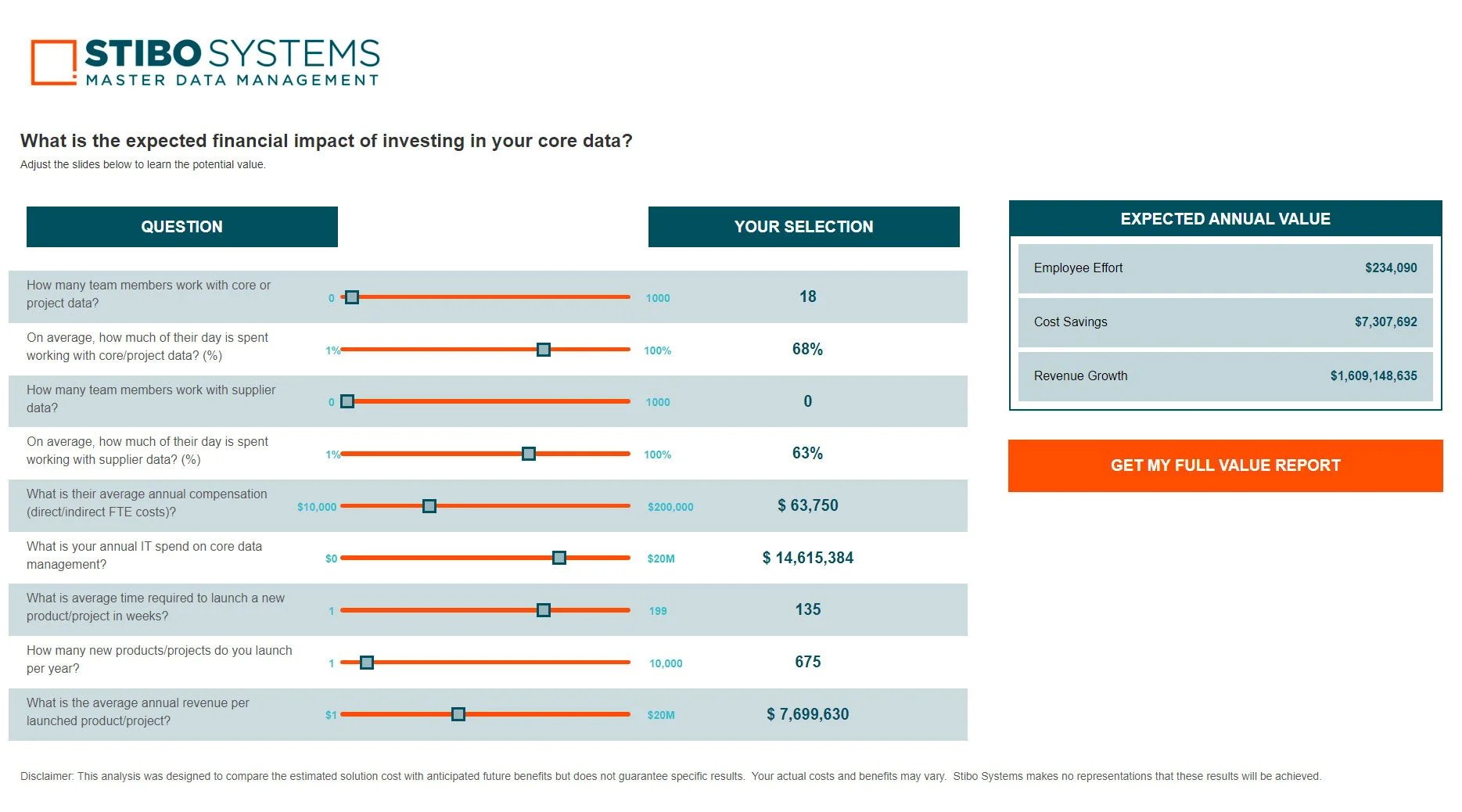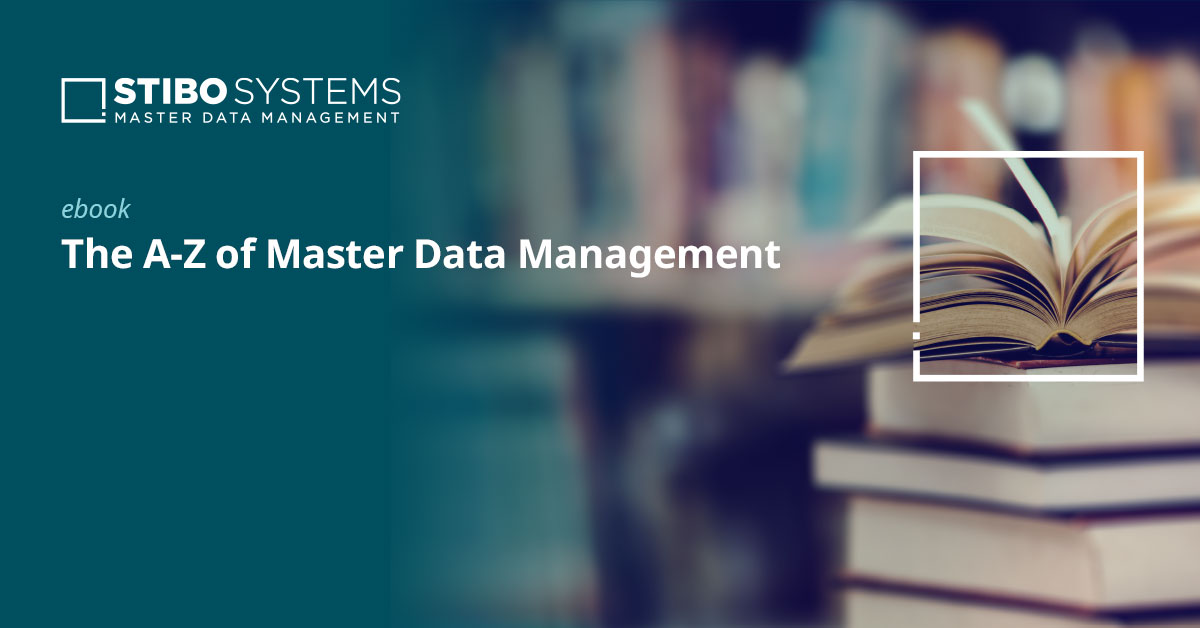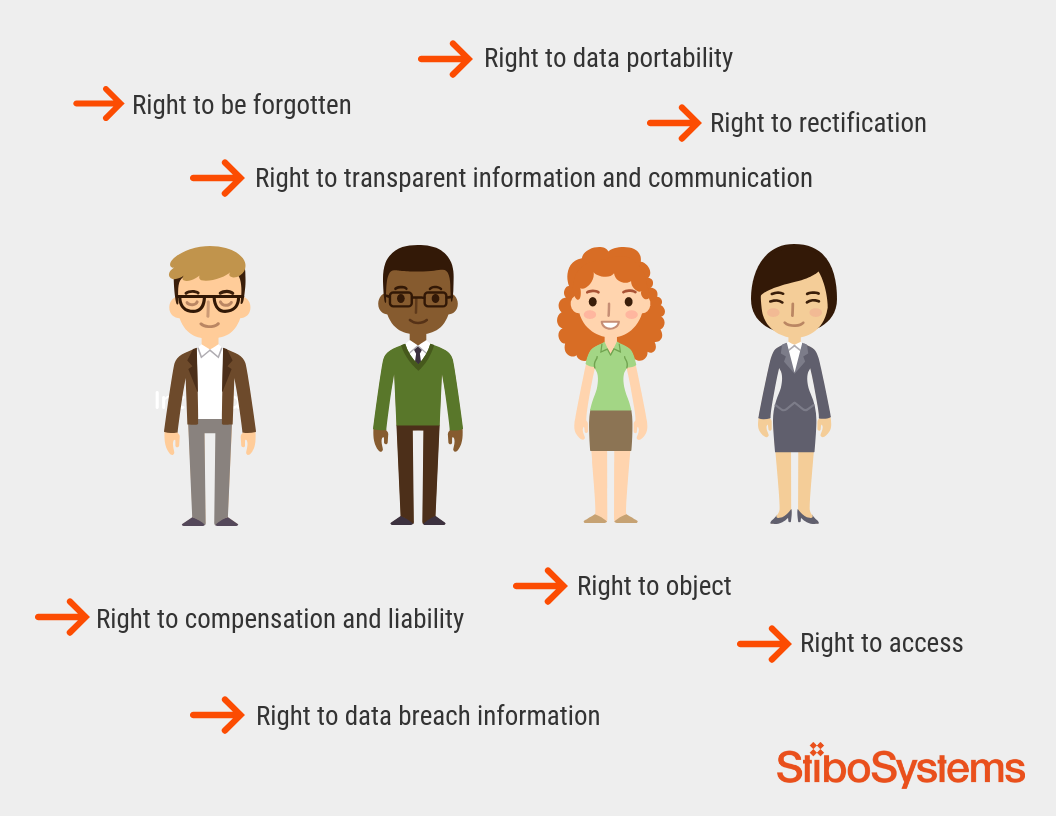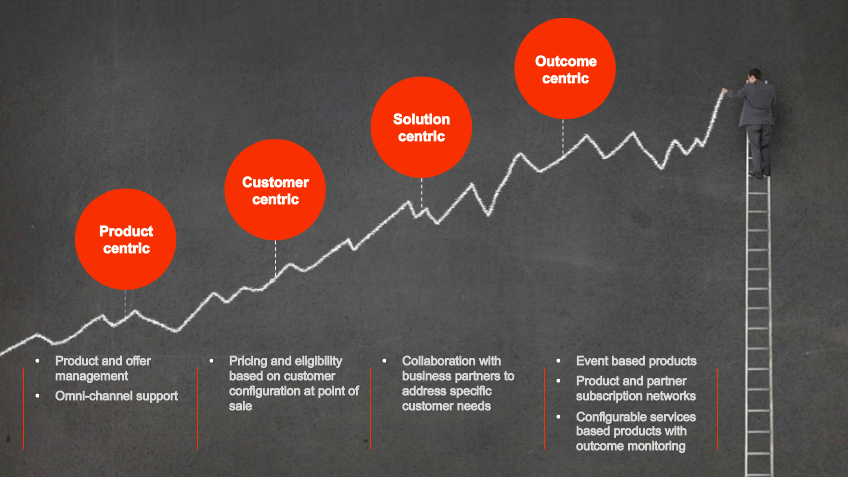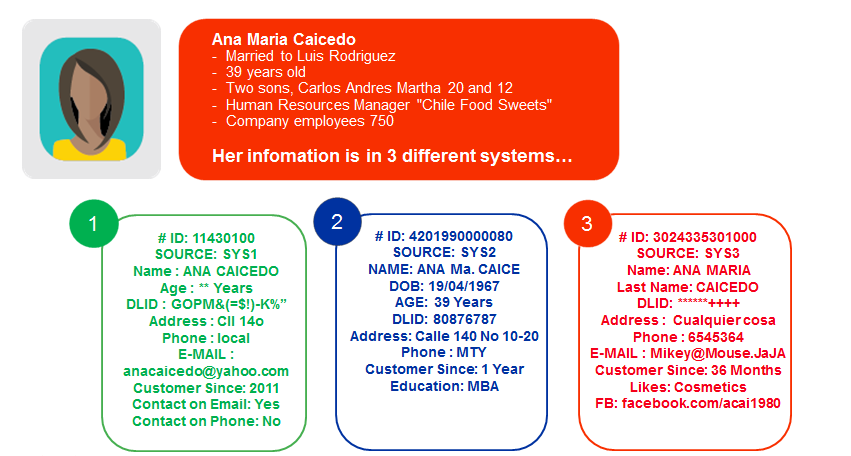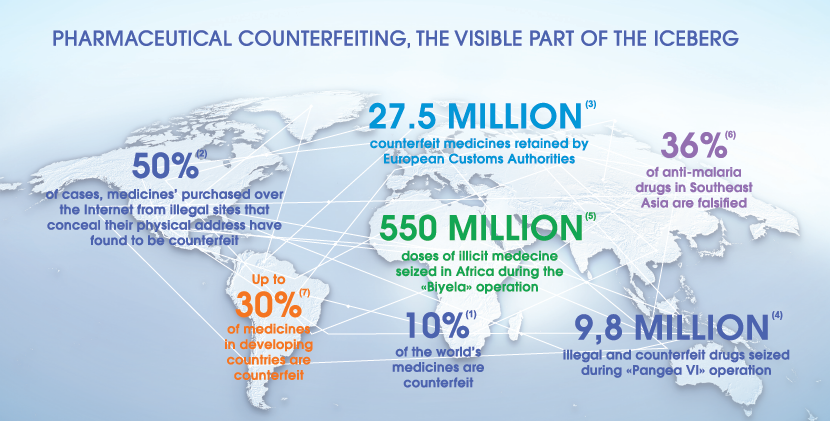High-quality master data and transparent processes are necessary to protect and grow your business. Master data governance helps you achieve it.
Transparency and high-quality master data are essential to everything related to your business: revenue growth, operational efficiency, risk management and compliance, analytics and digital transformation; and your ability to control costs and be agile.
The following discusses what master data governance is, why you need it, and how to implement it.
The exponential growth in data makes it paramount to get your data right from the beginning as catch-ups will be increasingly difficult and expensive. According to the 1-10-100 rule, it costs $1 to verify data as it is entered; $10 to cleanse and de-dupe each error; and $100 per error to operate a system with bad data.
- The Impact of Bad Data on Demand Creation, Sirius Decisions
Why master data governance?
Data governance is an enterprise-wide discipline with a vast purview. The picture of what data governance is gets easily muddled when you consider the many types of data: transactional data, behavioral data, performance data, temporal data, operational data and many more.
This article is concerned with master data and hence master data governance.
Master data describes the core building blocks (data domains) upon which your business is built. The people, places and things that interact to create the process of doing business. Master data is therefore the curated source of information that’s important to your business. Examples of master data entities include customers, products, suppliers, physical stores and locations, employees and major assets. Our What is Master Data Management infographic provides further details.
As it is essential for you to have trusted information about these entities, master data governance is needed to establish accurate identification and business relevant enrichment of your assets.
Having trusted information means you can replace assumptions with data transparency. As an example, many companies struggle with duplicate customer records, a situation that can result in bad customer experiences, loss of upsell opportunities and potential risks of fraud and data privacy violations. Furthermore, you can’t just delete records as they exist for specific business reasons. They have owners who need to access the information, they have different relationships, and it is not obvious which record has the most trusted, complete or up-to-date information.
As an organization, you need a single customer view across multiple lines-of-business, for differing purposes. And those different purposes will raise questions as to the actual definition or meaning of ‘customer’. Master data governance allows a glossary of agreed terminology to be created along with particular metadata attributes which are used to define ‘customer’ and provide a standard and consistent definition across the organization. This reduces the scope for misinterpretation, misuse, confusion and errors in the future.
The single customer view – a master data governance achievement
The highest degree of data transparency and trust amounts to a single, curated, view of your asset. Having a single view of, for instance, your customer enables you to uniquely identify that customer and understand its attributes and relations.
This is the indispensable foundation of becoming data-driven and getting the full business value of your data. Customer data can reside in different applications (ERP, CRM etc.) which makes it difficult to know which version to trust.
De-duplicating and merging different line-of-business views into a single customer view, also called a golden record, can provide you with the trusted source to be shared across channels as in this B2C single customer view:
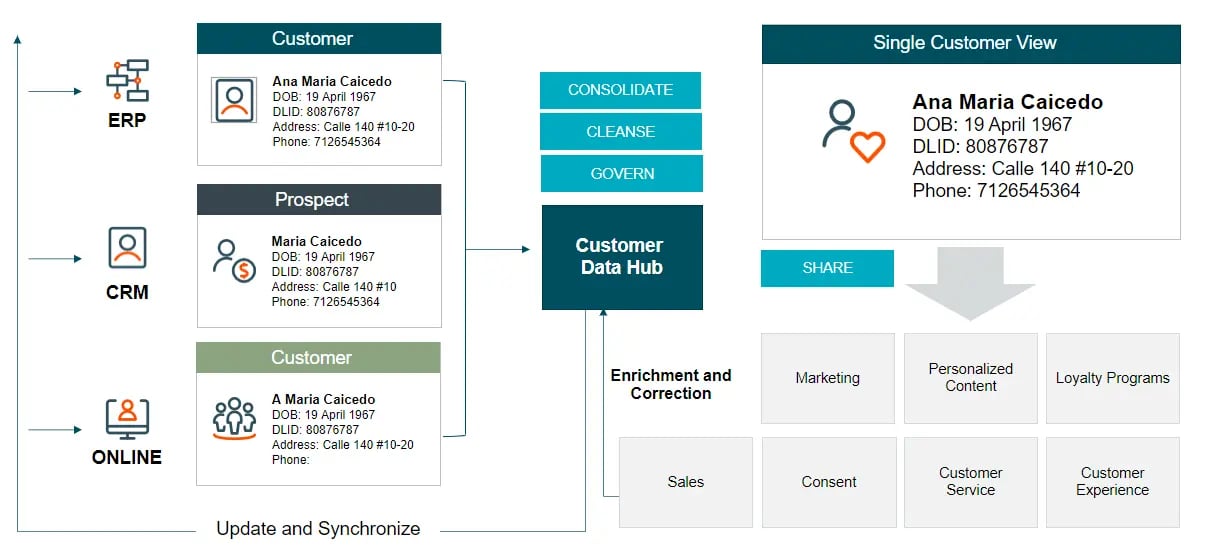
In order to reach that pinnacle of data quality and transparency, you need to consolidate and cleanse your data and govern data processes: Where is data stored? Where does it flow? Who uses it (and needs it)? And who can change it?
Clear policies and rules for acquisition, storage, management and sharing of master data are needed. But these policies need to be understood and enforced.
Hence, a strategy for master data governance must encompass people and processes, not just technology. That said, the implementation and enforcement of your data policies become easier if they are supported by appropriate technological capabilities, such as a master data management system.
Master data governance and master data management are not the same
However, your master data management can be an important tool to support your data governance strategy as it provides useful methods for data collection, classification, modeling, quality control, clerical review by data stewards as well as linking-and-merging capabilities for automated de-duplication.
As the diagram above shows, by connecting applications and unifying data, the master data management that harbors the customer data hub, effectively breaks down siloed data management, which is the single most important impediment for achieving data transparency and accountability.
Problems if you have ungoverned master data
Master data governance (in fact all data governance) is often seen as CDO responsibility and as an administrative and compliance overhead. However, master data governance is not just needed for tick box exercises, it directly impacts the business’ ability to scale and achieve new goals. It is even necessary to prevent your business from leaking money here and now.
Having ungoverned data means you will inevitably spend valuable time on manual processing and putting out fires.
Ungoverned data cause goods to be dispatched to wrong addresses or customers receiving goods that don’t match the publicized descriptions. Both resulting in bad customer experiences, loss of reputation and loss of loyalty.
Among the more subtle effects of poor data quality are:
-
Missed opportunities to upsell to a customer because you can’t accurately identify the product categories that they purchase
-
Time wasted on correcting and re-processing
-
Not being able to negotiate purchasing discounts because the supplier is duplicated so many times that you can’t say what your total spend is
-
Losing web sales because your inaccurate sizing data makes you look bad on comparison sites
-
Lack of insight into your supply chain, including sourcing and manufacturing methods, use of sub-contractors, etc., can cause expensive recalls and brand damage
-
Ungoverned master data hampers the ability of manufacturers to share accurate information with distributors and retailers
-
Lack of rules around product master data can impede compliance with data standards and requirements, such as government and trade regulations, or GS1 standards
Finally, inconsistent data across systems and processes leads to lack of confidence in your analytics, so that intelligence becomes subjective and decisions become based on opinions rather than facts.
Formalize your data governance
People in your organization are already doing data governance as part of their regular job. For example, the accountants are probably ensuring that postings are made to the correct ledger codes, your accounts payable department is ensuring that invoices are sent and matching payments are received.
Much of your operational data is already part of an active management process but to a large extent their interest is in quantities and values.
The areas that get less quality checking are the master data that drive many of your business processes. Master data governance aims to put in place formal management responsibilities for the overall quality and reliability of this data.
One of the changes in attitude that is driven by data governance is to move away from a reactive approach to quality into a more proactive approach.
Often poor data quality is only found when a business process fails – when a delivery can’t be made or when your IT system stops working, which is hardly the best way to find problems. It is also common when disasters occur through poor data quality that nobody can be found to take responsibility.
Data governance ensures that somebody is clearly responsible – not just for fixing the disasters but also for reducing the likelihood of one occurring.
Key elements of master data governance
Every organization is different. There can be no universal one-size-fits-all framework for master data governance, although there are key elements that everyone must pay attention to.
These include transparency, maintenance, data ownership, change management, compliance, accountability, authority, auditability, data stewardship, standardization, and education.
Many proponents of data governance have fixed models which have been proved to work in previous engagements. The issue is that many of these fixed solutions disregard your organizational capabilities.
Use the steps in this infographic as a starting point for your master data governance journey:
Many vendors claim to offer data governance tools, and there are certainly tools that can help you govern, tools that can enable you to store and communicate the defined business rules, tools to measure data quality, and tools to identify compliance issues.
But governance is about the organization, the processes, and the responsibilities within which such tools can be deployed.
Without the correct organization the benefits of these governance tools will not be realized.
Data maintenance needs to be governed, too
Is data governance the same as data maintenance? The two are very closely linked through data quality but they are independent functions.
Maintenance organizations tend to be aligned with specific IT systems or with specific lines of business (LoB) within your organization whereas data governance is about a common set of rules that everyone should adhere to.
The key to understanding this dichotomy is to understand the two parties’ relationship to standards.
As part of master data governance, you need to define a set of best practices or principles that will ensure that you create and maintain good quality in your data.
Define these as your standards. It is the role of the data maintenance teams to comply with these standards, but it is the role of data governance to define the standards and to ensure that they are being met.
What is data ownership?
Data ownership is a very confusing term. For example, it is common in businesses to split data responsibilities geographically – the UK sales force manage all customers and their data in the UK region whereas the US team take responsibility for those in the States.
But then again, we are proposing a single data governance organization that is responsible for the data, and to add to the confusion, in many such governance organizations we see a role of data owner.
But actually, the data governance organization’s role name “data owner” is a misnomer because in practice what they own is not the data, but the standards (the principles and best-practices) that guide the users in how to achieve good quality.
So, while many departments may lay claim to the contents of the data it is the data governance organization that owns the structures and the quality rules.
What activities does a data governance organization perform?
When viewed at a high level the data governance organization only performs two activities, but in practice these two activities can be very complex and can require a network of resources to achieve them. The data governance team is responsible for change management and compliance.
Change management – Once you have defined a set of standards and have aligned your data to these, then it is important that changes to these standards are controlled.
For example, if you define that all dates are stored in the UK format of Day/Month/Year then it’s a big issue if somebody wants to change to the European format of Month/Day/Year.
The data governance team has the job to assess the impact of any such change, to liaise with any relevant stakeholders, to measure the cost and benefit of such a proposal and then, if the change is deemed appropriate, to manage those changes across all affected areas of the business.
Compliance – Wherever there are rules there is a requirement for a policing. The data governance team must be that police-force – to measure the organization’s compliance to any standards that it governs and to act to improve the level of that compliance.
Outline of a data governance organization:
How to get started with master data governance
As stated above, there is no one-size-fits-all, yet as a minimum, you need to consider the following steps towards a data governance program:
- Make someone accountable for the program, e.g., a CDO
- Make it central to all data management disciplines
- Assess where you are – you can use a maturity model – then plot your journey
- Define roles and responsibilities
- Measure progress by setting KPIs
When digging a little deeper into the program, the next level could consist of these six blocks.
Six steps to build a data governance program:
1. Build a clear vision for your desired data quality and processes
Ensure you have a clear vision and scope for your data governance initiative so that you can ensure that your organization is able to fulfil it.
2. Define data standards
Each standard should have a business rationale as to why it exists, defined benefits that can be achieved from having the standard, definitions of what level of quality should be achieved to realize the benefit (not always 100%), and metrics that will show that the benefits are being realized.
3. Design a data governance organization
This organization must be suitable for managing the standards you have defined. This includes the roles and responsibilities for those governing data, the internal governance processes that will be used to manage activities (such as the change management for standards), and changes to any external process that affect the organization’s ability to govern (such as the IT project management process).
4. Engage your data owner
– to own your standards and to build the data quality roadmap.
5. Build a data quality roadmap
The roadmap must document your current quality level. Measure this against the requirement defined in your standard and propose actions to bridge the gap and/or maintain good quality.
6. Populate the remaining data governance roles
Engage resources for the data governance roles which are needed to operate the on-going compliance measurements and to manage the activities identified in the data quality roadmap.
How can you make sure that your data governance organization succeeds?
One of the keys to a successful master data governance organization is authority to address when someone refuses to comply with your standards.
Where there is no authority, you usually find the growth of local standards and the proliferation of complex interfaces to manage the transition between areas of the business with differing standards.
As the number of standards increases you eventually come to the point where there is no standard at all.
The types of businesses that often have issues such as this, are those that have grown through acquisition but have kept management of these subsidiaries at arm’s length. Conversely the most successful data governance initiatives are in the pharmaceutical industries where compliance to standards is enforced by external agencies.
Data governance is not complicated, in principle, but its application can be become both complicated and very political.
It benefits from having expert guidance to design but it also requires local knowledge of the enterprise and its peculiarities to build something that works in your situation and delivers real benefits.
How master data management helps you govern your master data
Ensuring data definitions from the beginning can provide high quality of data throughout the data lifecycle. That way, data stewards and data owners across the enterprise can work with accurate data. This is where master data management can help: by defining permissions and tasks for users at granular level.
Master data management can automate the execution of processes making data flow from department to department in a seamless manner.
Rules and gates between workflow states enable audit trails that help data owners track changes that are not authorized. This ensures operational efficiency while maintaining accountability.
Below are two examples of how master data management can be configured to support and enforce your master data policies.
1. Customer data governance
The screenshot below shows completeness statuses for an organization’s customer data policies. The screen lists all configured policies with some general metric at the top (in this case number of current breaches) and each current policy score. In addition, you can see from which business application customer data is fed into the master data management.
These policies can be sorted and filtered through the toolbar from which you can also create new policies. The policies are based on a metric and a dataset.
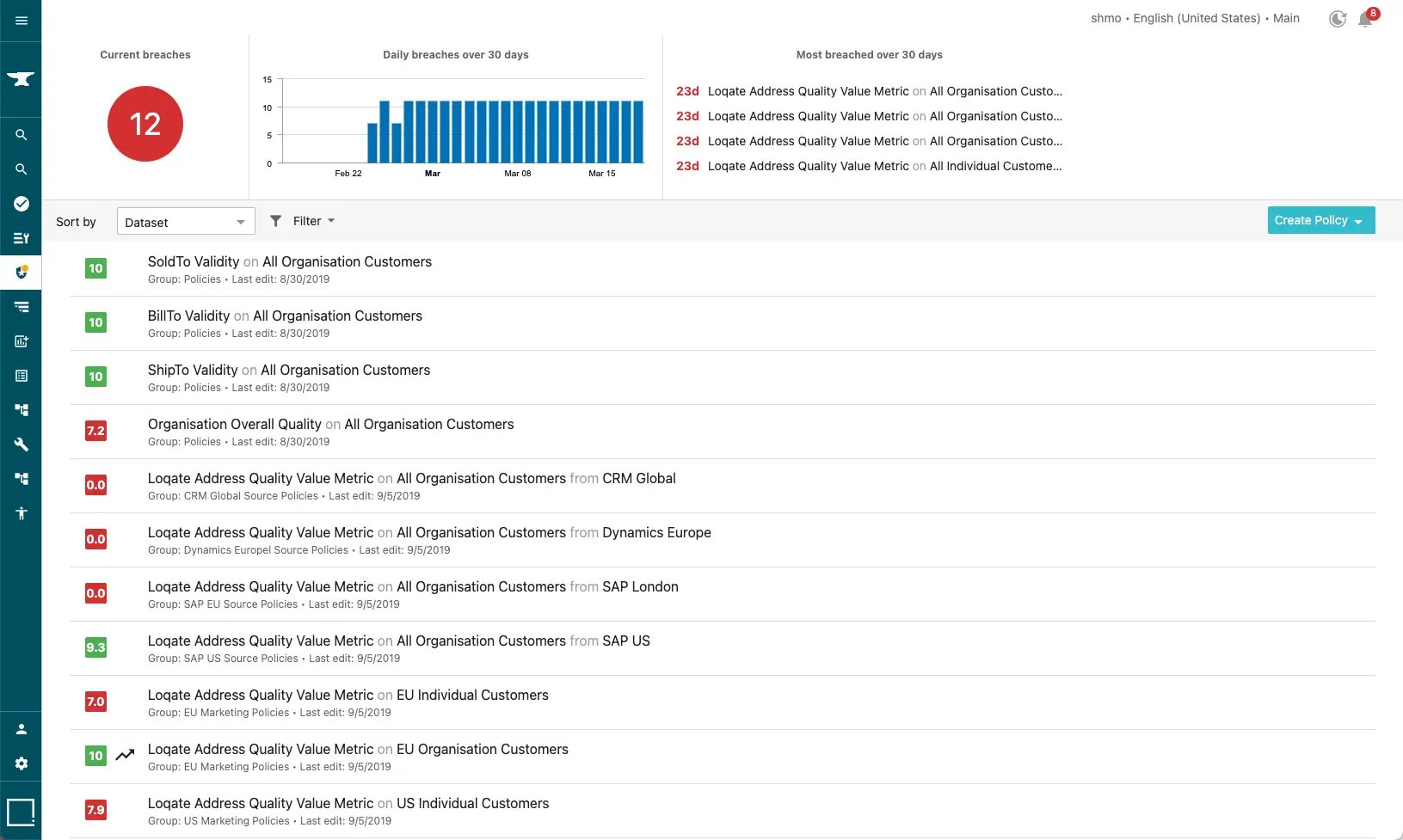
Diving into one of the customer data policies, you get a historical chart of the policy score with some snapshot data widgets on the left and a timeline of policy activity on the right.
From this screen it is possible to edit the policy status, breached threshold, and accepted deviation per scoring period. You can also subscribe to the policy and receive email notifications through the toolbar.
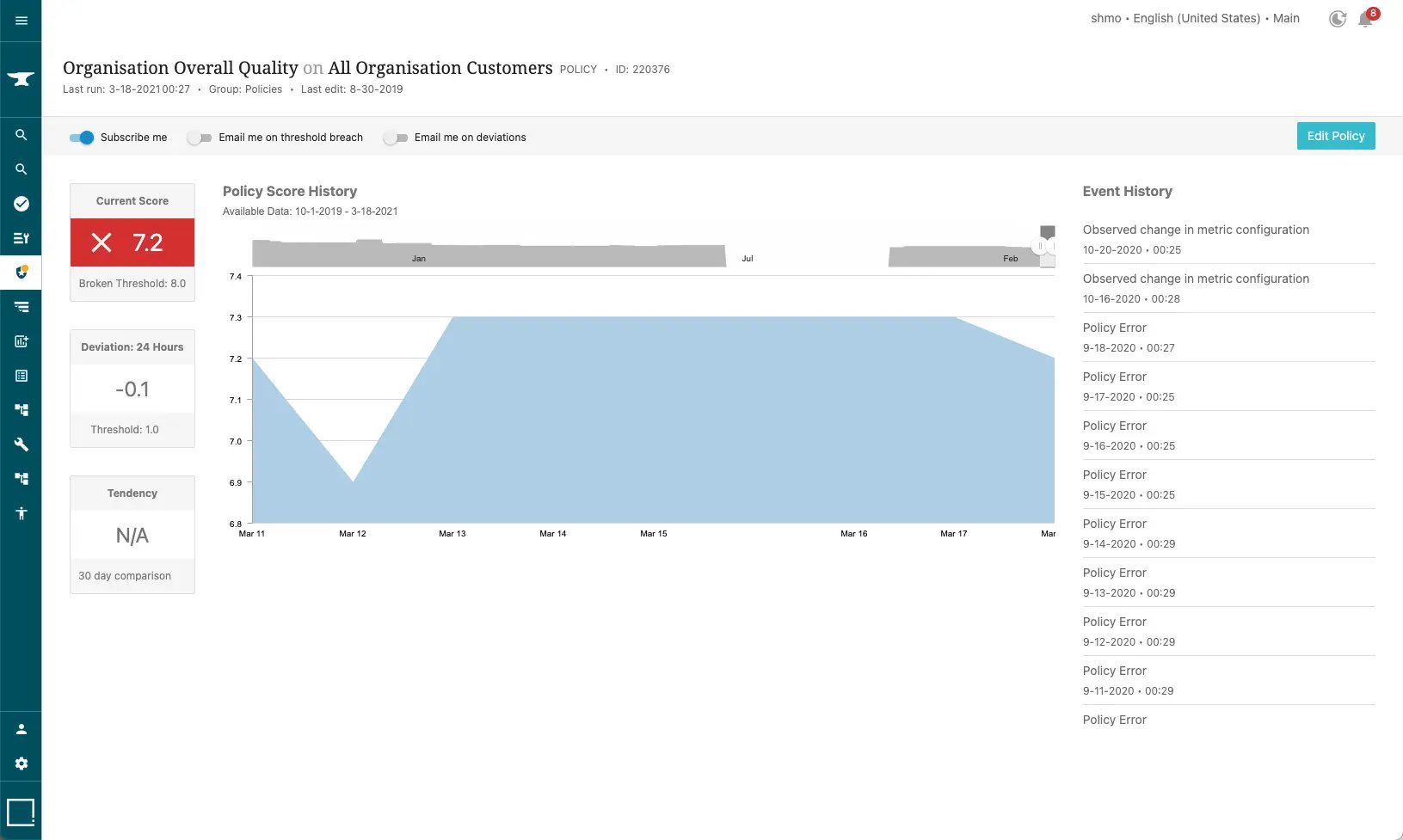
This capability of viewing and editing customer data policies at high and granular levels supports your data quality goals, as well as the auditability by highlighting which processes need your attention.
2. Product data governance
The screenshot below shows an example of a product data configuration to ensure that a certain level of quality is met before the product can be pushed to the next state in the workflow. As part of the workflow, the product manager needs to fill in marketing information on three pairs of jeans. The three product attributes, Feature Bullets 1-3, are mandatory.
This gate in the workflow ensures both data completeness and accountability.
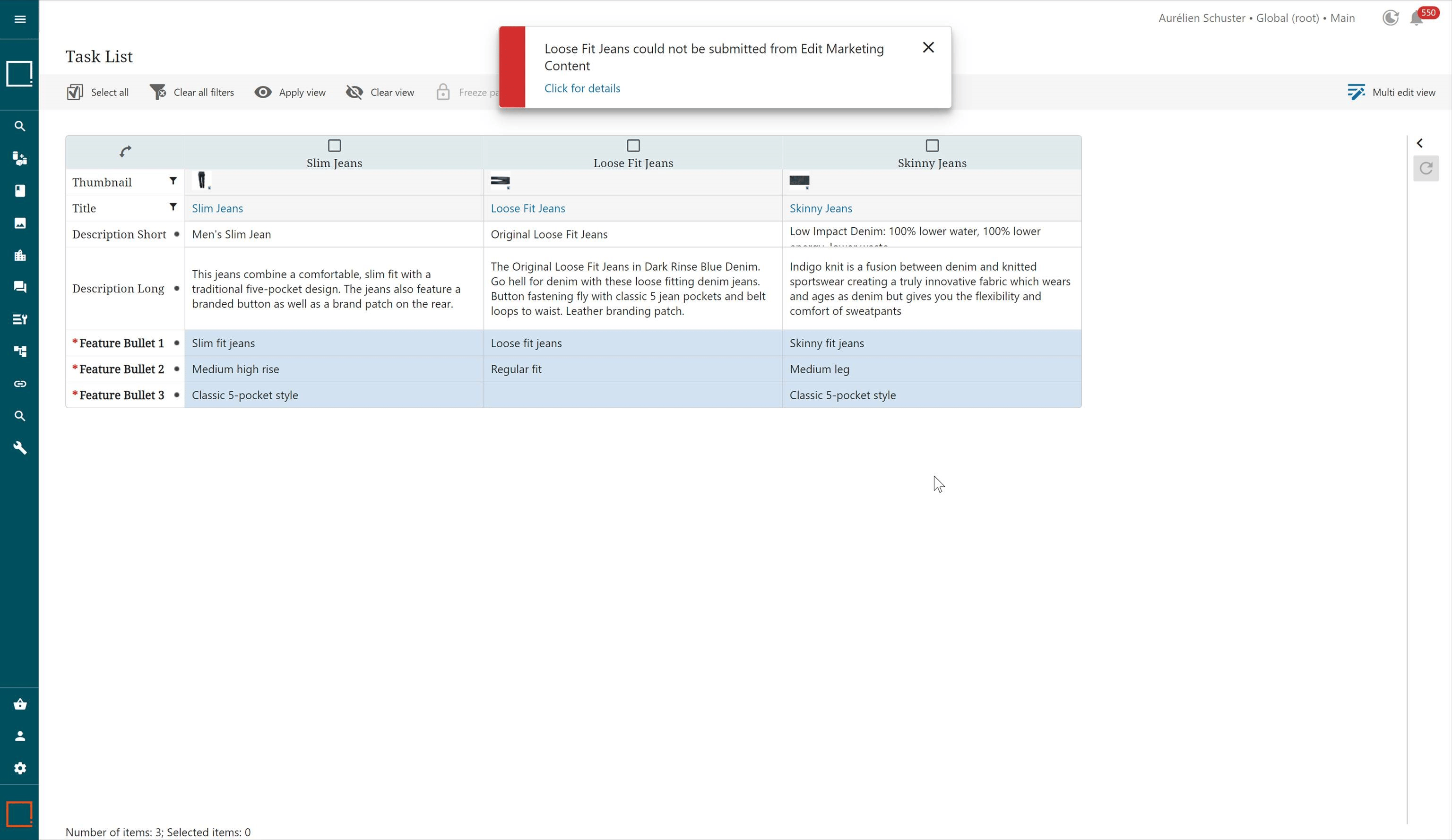
The screenshot below exemplifies how the master data management allows you to configure tooltips for each product attribute to inform the user of what kind of value they are expected to key in.
Furthermore, the user can open a wiki page with more information on the attribute itself (when, what, who created it, etc.). Each attribute is defined with a type, such as text, item number, list of value, and with each type there are attribution validation rules, such as min-max value, max number of characters, etc.
If a value does not comply with an attribute validation, then the master data management warns the user with a color code and prevents the user from saving the item.
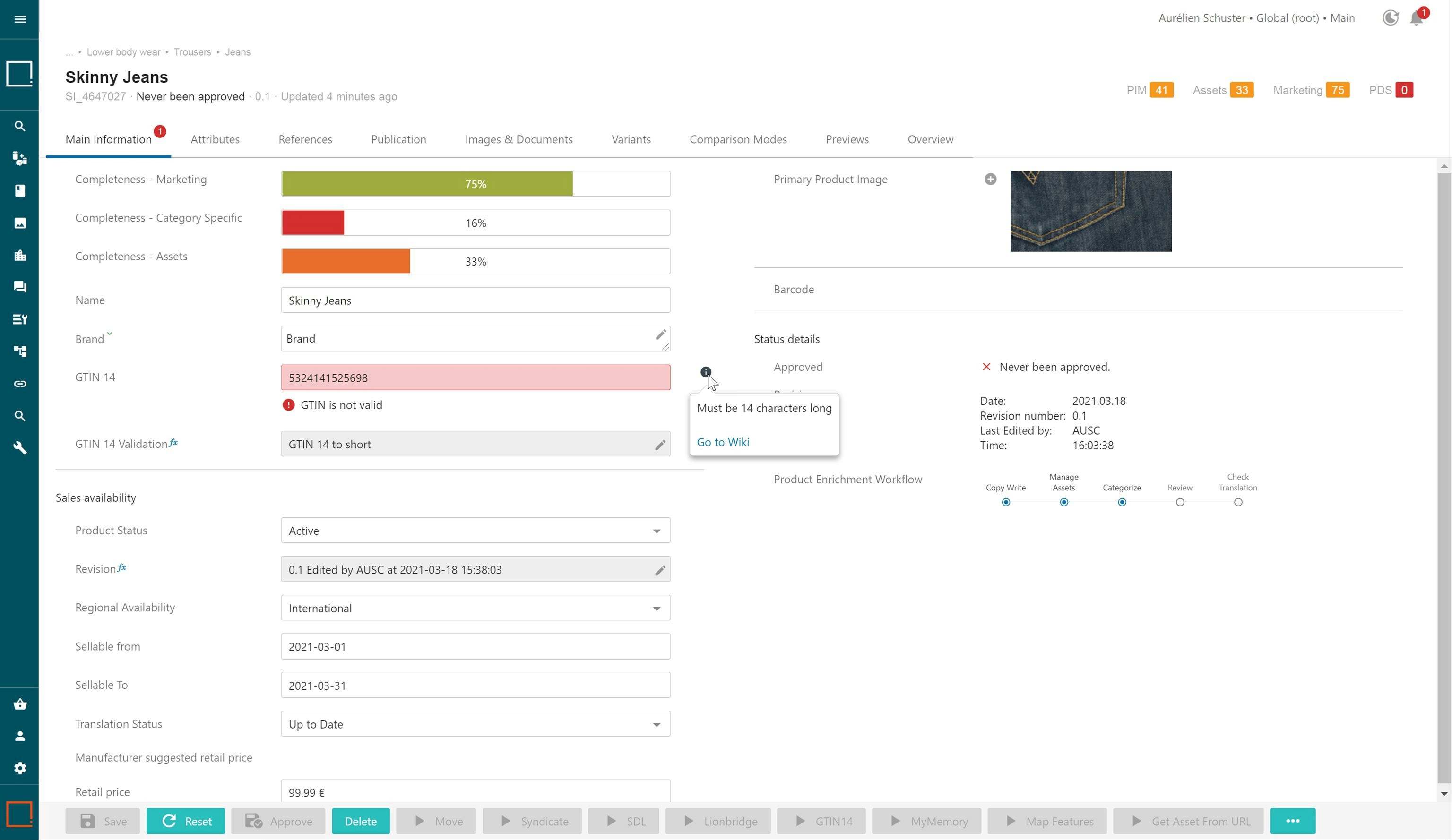
Master data governance needs definitions
Master data management can’t work without governance. But to take one step further back, you can’t implement a data governance framework without definitions.
Data collection, classification, and quality control must be applied before implementation of a data governance framework. You need to have clear definitions of things like acquisition and accessibility in order to govern data; and these are essentials of master data management.
In that sense, your master data management and your data governance framework are mutually dependent.
Learn more about master data management and how it supports your master data governance.

